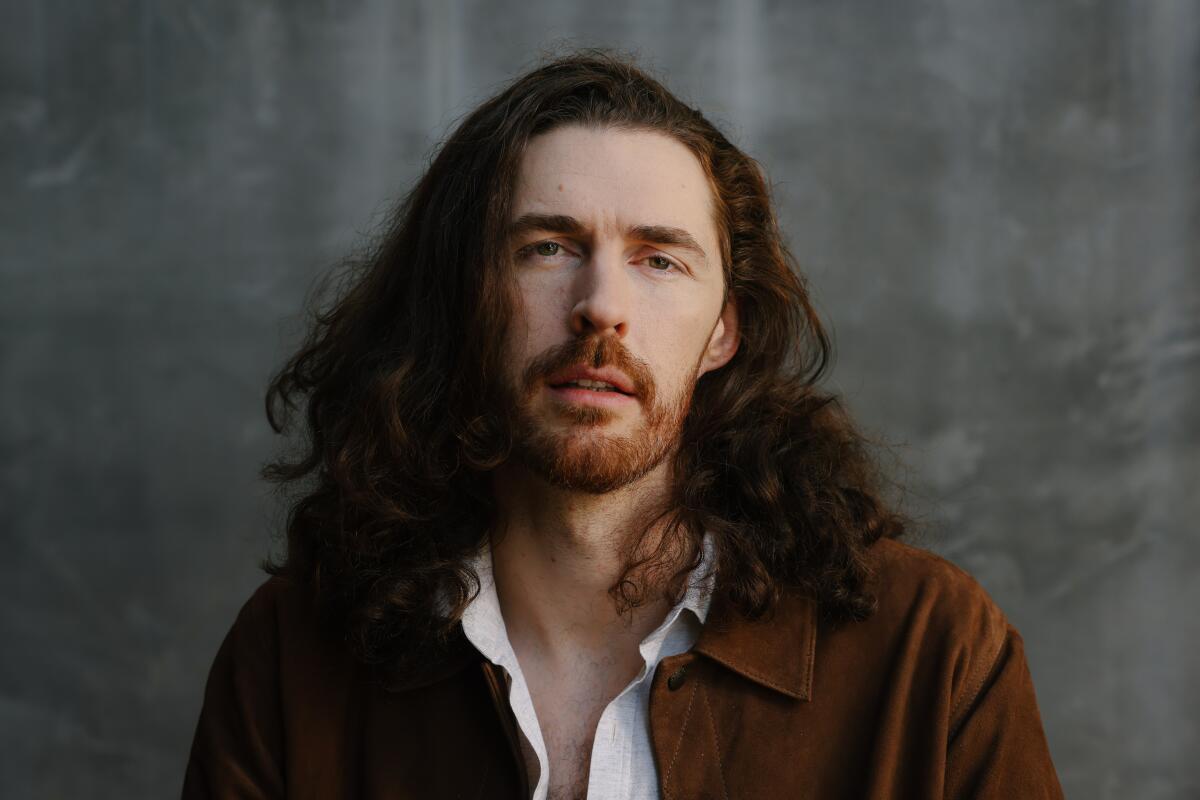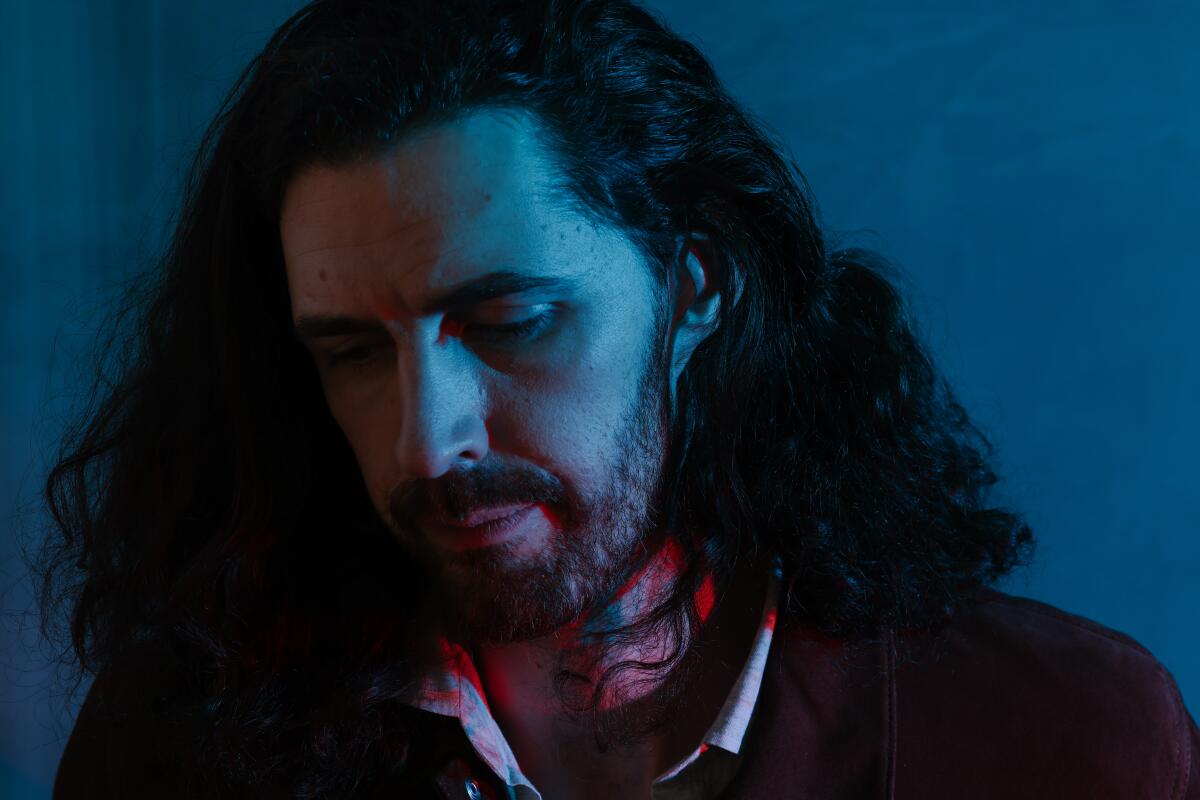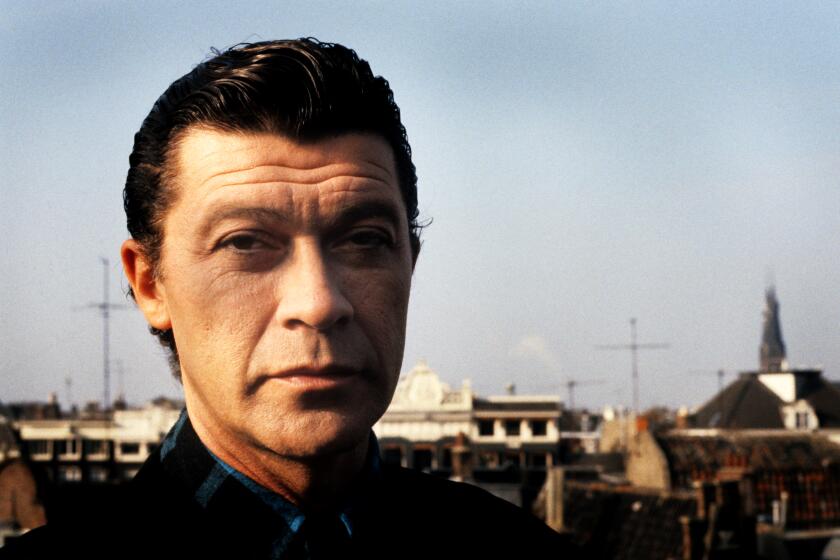How Hozier found ‘a renewed sense of joy’ while contemplating hell on earth

- Share via
“Thank you for suffering through my ramblings,” Andrew Hozier-Byrne says, just before logging off our Zoom call.
The Irish singer-songwriter known as Hozier is speaking from Berlin, in the midst of a U.K. and European tour that extends to the U.S. in the fall, and includes sold-out shows at the Hollywood Bowl and Santa Barbara Bowl.
On this day, he’s eager to discuss a castle at which he performed in Cardiff, Wales. “We were right next to this keep, which has a moat around it, which was originally built by the Romans,” he explains, playing straight into the “bog daddy” and “forest god” personae the Internet has bestowed on him. “The earthworks were used by people for centuries as part of a castle and part of it is still standing. It was a really lovely place to play.”
On Aug. 18, the 33-year-old musician, best known for his haunting 2013 hit “Take Me to Church,” will release “Unreal Unearth,” his third studio album and a work that he’s been teasing for months on social media and through the EP “Eat Your Young.” Its 16 tracks are loosely inspired by the first part of the Italian epic poem “Divine Comedy,” Dante Aleghieri’s imagined journey into hell titled “Inferno,” but it doesn’t stray from the singer’s favored themes of love, loss and social consciousness.
“I’m definitely coming out of the last three years having done plenty of internal janitorial work,” he says. “I’m coming back with a renewed sense of gratitude and ease … a renewed sense of joy for what I get to do in this life.”
This interview has been edited for length and clarity.

Musicians tend to be allergic to the idea of a “pandemic album,” but I wonder: How much is “Unreal Unearth” an exploration of hell vis-à-vis Dante’s “Inferno,” and how much is it a pandemic album? It strikes me that the arc of those two things are somewhat similar.
I’d hoped that these songs could live above ground and below ground at the same time, if that makes sense, and that they’re in sympathy or harmony with each other at points. I share that allergy with other musicians, I really do, but I think it’s silly not to credit the experience of the last three years in some way. How I settled on doing that was just to make this collection of songs, let them be what they needed to be in that time period, and then structure them into nine circles as a nod to the journey of descending into this place we didn’t really expect to find ourselves.
You’ve said that the ideas you were workshopping on the road just prior to the pandemic suddenly felt frivolous. Why?
When the pandemic landed on top of everybody, it felt like there was this new precarious situation where fear felt so much more immediate, so much more real, so much more urgent than some of the stuff I was kicking around. I have so many people in my family who are immunocompromised. Some of the concepts I’d been working on were legitimate, but they just seemed cartoonish by comparison.
A look back at the best of Robbie Robertson, the pioneering Band songwriter and guitarist who died on Wednesday at 80.
You’re known for doing what Nina Simone once called for, which is to reflect the times. That rings clear on songs like “Eat Your Young.”
It was a sentiment I had been walking around with but had never put into words. So when the lyric about skinning the children for the war drum came, and putting food on the table by selling bombs and guns, I decided to write something from an unreliable narrator’s perspective, a voice that is sort of relishing in that activity, that voracious appetite for taking all that you can and damn the expense, damn the human cost. Once I had those lyrics, I thought it could be fun sounding and sort of under the radar, slipping in that subversive line. There’s no money like arms dealer money, and I’m just being straight about it. There’s so much conflict and so much profit from conflict.

That’s a Hozier signature, wrapping all this lyrical heaviosity into easy little pop packages. But conversely, the song “Francesca” is an explosive rock song. How do you feel about the state of rock music in 2023?
I think it’s on the way back. People are connecting with music they can write and play themselves, something that can be played live, in social settings. That’s the magic of the guitar. In a way, the laptop has become the new folk instrument; you can really create anything on it. But it’s nice that people are returning to something more tactile with acoustic and electric instruments. I hear a lot of grunge, shoegaze and early ’80s emo stuff today. I can feel the Cure in a lot of modern songwriting.
You recorded the album here in Los Angeles. Where did you stay?
I was Airbnb-ing a lot of that time, and I would just pick a neighborhood and spend a month there. I stayed in Silver Lake, close to Echo Park, West Hollywood, Abbot Kinney in Venice and Studio City. I moved around a lot. I spent upward of six months, maybe more, there, which was my first extended period of time in L.A. Some friends who I went to college with are working there now, and I was able to foster a little community around me.
As hip-hop celebrates its 50th anniversary on Aug. 11, The Times looks back at the artists, songs and innovations that changed the course of popular culture.
Brandi Carlile features on “Damage Gets Done.” Why’d you connect with her?
She’s a total hero, somebody who’s driven by such a vision of community and love. She also has an outrageous voice. We were looking at songs from the ’80s and early ’90s where people really sing out. We were channeling some power-ballad type of stuff. It was clear to me that this song was a duet in the vein of Kate Bush and Peter Gabriel’s “Don’t Give Up,” like a “these are hard times but we’re gonna get through them” type of sentiment.
Taking stock of the American musicians you’ve worked with or paid tribute to over the years — Nina Simone, Mavis Staples, Booker T. Jones and many others — I have to imagine you’re a bit of an old soul.
I don’t know. I’ve been called that, and I have felt tired for most of my life.

Songwriters are often subject to the misconception that their lyrics are autobiographical. Where is the line between your life and a character you’ve created?
The character thing is a helpful device to allow the song to live in two worlds. It’s also a helpful device for dodging questions exactly like this! But I don’t mind saying that they do come from a very personal place. In particular, on this album, some of the songs I wrote for my partner at the time, things I sent to them first just as a gift, and then they ended up as part of this. “To Someone From a Warm Climate” was written for someone from a warm climate who I was involved with. Part of it was explaining to somebody the actual lived experience of getting used to warming up a freezing cold bed as a child in winter.
How was the lockdown for you? Did you feel particularly well suited for it because you’re someone who requires alone time?
I definitely feel very comfortable alone. So there was part of me that was thriving in that sort of solitude and quiet, at least for a while. I started keeping bees. I would meet my friends at dawn once a week by the seaside, and we would swim and watch the sunrise. I watched some of my friends have their first children. I got to live a life that was very different from what I’d been living for the majority of my 20s.
That’s very poetic.
Seamus Heaney has this beautiful poem about playing football after dark, and it was sort of similar. It was a time that was … unpredictable, unforeseen and free. There was definitely something to cherish in that.
More to Read
The biggest entertainment stories
Get our big stories about Hollywood, film, television, music, arts, culture and more right in your inbox as soon as they publish.
You may occasionally receive promotional content from the Los Angeles Times.












